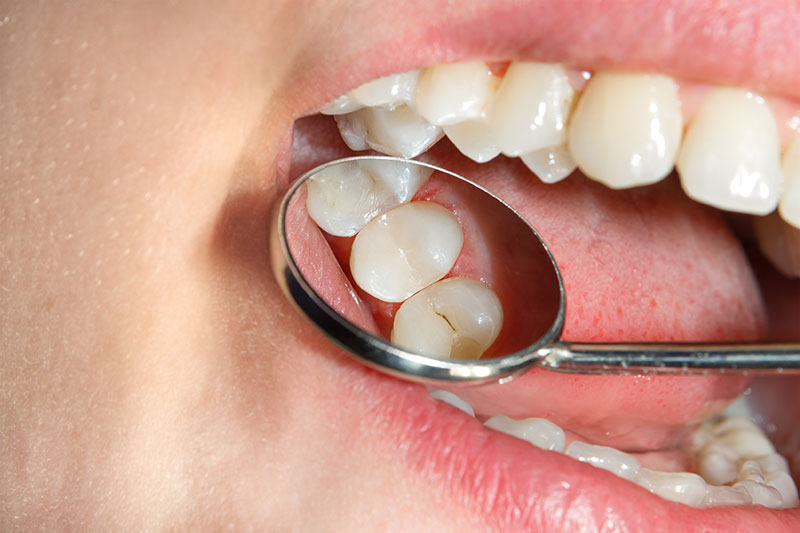Dental Sealants Solutions
Dental sealants provide a layer of protection from decay for the teeth. They’re mainly used on the molars in the back of the mouth.
What Are Dental Sealants?
Dental sealants are made of a plastic material that is applied to the teeth to protect from tooth decay. Dental sealants fill in the back molars’ deep grooves where food and bacteria can collect that can cause cavities. With dental sealants in place, plaque is sealed out. Dental sealants are not a guarantee against the formation of cavities, but they offer the best protection available. They are also no substitute for routine brushing and flossing.
Who Can Benefit From Dental Sealants?
Dental sealants are popular for children who may not always brush as thoroughly as they should. Adults, too, can benefit from dental sealants.
Adults
Adults who opt for dental sealants on their back molars do so for long-term cavity protection. They find that the sealants protect the teeth for as long as a decade.
Kids
Kids have difficulty brushing properly because they often lack the proper dexterity. With dental sealants on their back molars, these teeth are protected from developing tooth decay.
Teenagers
Teenagers have the dexterity to properly brush, but they are often sloppy when it comes to personal hygiene — including tooth brushing. Sealants provide protection from cavities caused by sugary foods often consumed by teens.
Dental Sealants Procedure & Application
The dental sealants process is fairly straightforward. It includes:
- First, the dentist applies an acid solution to the teeth to roughen them up. This helps the tooth coating adhere to the teeth.
- Second, the teeth are rinsed and dried.
- Next, the dentist applies a thin layer of sealant to the teeth. It dries quickly — and the process is complete.
Teeth Sealants
Dental sealants are a preventative measure. They protect the teeth used for chewing from developing cavities.
Tooth Fillings
Tooth fillings are used after a cavity has formed. They are essential to stop cavities from getting bigger.
Benefits of Tooth Sealants
Some experts believe that tooth sealants can prevent as much as 80% of cavities. Other benefits include the following.
Dental Sealants Are Long-Lasting
Many adults and children choose tooth coatings because of the long-term protection. They find that their dental sealants can last for as long as a decade.
Dental Sealants Are Safe
People can be confident about the safety of the plastic used to make dental sealants. It is known to be free of BPA, a harmful chemical to the human body.
Dental Sealants Are Often Covered Under Insurance
Dental sealants are considered a preventive dental procedure. So, many insurance companies cover the cost of this procedure.
Dental Sealants Provide Immediate Protection
The dental sealant procedure takes just a few minutes. However, patients have immediate protection from tooth decay.
Dental Sealant After Care
Dentists recommend using care after getting dental sealants. This will help ensure they last for as long as possible.
Stick to Soft Foods Immediately After Getting Dental Sealants It is recommended that you only eat soft foods for the rest of the day after getting a teeth coating. Avoid foods such as hard candy and popcorn. You can resume a normal diet the next day when the sealants have hardened completely. You can also brush and floss normally.
Dental Sealants Are No Guarantee of Cavity Protection
It’s essential to brush and floss regularly after getting dental sealants. You should also be sure to keep up with routine visits to the dentist for examinations and cleanings.
When to Replace Dental Sealants
You can expect dental sealants to last as long as a decade with adequate oral care. Here are some things to think about when considering replacing your teeth coverings.
Dental Sealants Do Not Need to Be Removed
Your dental sealants will deteriorate over time. So, you do not have to worry about having them removed. Your dentist will be able to tell you when it’s time to get new sealants.
Your Dentist Will Check Dental Sealants Regularly
Dental sealants are most effective in the first few years after application. Your dentist will monitor them for effectiveness as part of your routine dental examinations.
Getting Your Dental Sealants at West Coast Dental
At West Coast Dental, we provide dental sealants for adults and dental sealants for kids around the Greater Los Angeles area. This quick, painless procedure requires no anesthesia.
Team of Board-certified Specialists
Our team is made up of experienced general dentists and board-certified specialists so you and your family can get the dental treatment you need. Our state-of-the-art practice helps to ensure you get the highest standard of dental care available in Southern California.
Same-day Appointments Available
We welcome you to reach out to us if you have a dental emergency. We leave room in our schedule for same-day appointments when they are needed. Schedule yours today.
Accept Most Insurances
We are pleased to accept most dental insurance plans. We also offer a variety of payment options to accommodate your budget.
Dental Discount Program
We don’t want finances to keep people from getting the dental care they need and deserve. To that end, we offer a dental discount plan to help keep expenses down through the Dental Alliance Discount Plan. We also offer financing options through Dental Alliance Financing and CareCredit to help keep treatment affordable.




